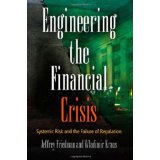
Engineering the Financial Crisis:
Systemic Risk and the Failure of Regulation
by Jeffrey Friedman e Wladimir Kraus
University of Pennsylvania Press, 2011
pp. 224
Review by Antonio Foglia
One of my more politically and financially alert friends called my attention to Friedman and Kraus’s book, noting they had similar views to mine. Having so far only expressed them in one paper [1] and numerous newspaper articles, I realised from his tone the added credibility that comes from putting them in a book…
This book’s thesis is that the financial crisis is due to a cognitive, not a moral, failure as it was caused by the unavoidable mistakes made by the regulatory authorities. The authors start by discussing and dismissing many of the different causes suggested for the crisis. Then they demonstrate how it was embedded and unavoidable in the body of regulations imposed on financial institutions. Lastly they discuss the profound implications of this and what should be done differently.
In essence the authors argue that the economy and regulation are complex dynamic systems. I have looked for years at complexity and ecology as new paradigms to understand the economy better and this book is one of the most convincing cases I have come across to date for embracing this model. The policy implications of this view are wide and deep.
The authors demonstrate that the crisis was triggered and precipitated by the unintended and unavoidable negative consequences of a series of regulations enacted at different times and with different aims. Unintended because no regulator can foresee the ramifications of its actions on the economy, given its complexity and the complexity of the existing body of regulation with which it interacts. Unavoidable because our imperfect knowledge and fallibility make errors, particularly by regulators, a certainty.
The authors conclude that the best way to cope with a complex world populated by fallible humans with limited knowledge is to foster competition among heterogeneous ideas and projects of agents held responsible for their actions, in a robust process quite similar to biological evolution. Regulators and politicians interference with the process, is not only almost certain to be counterproductive in the long run, but also imposes and crystallises the majority view which is just one of the possible views. Moreover regulators and politicians have no better chance than anyone else of being right although they will be far slower to learn from and correct their own mistakes, having weaker and conflicting incentives to do so.
The authors do not push the issue further, but the implications of this convincing world view are substantial. First, letting the market discovery process run its course through creative destruction entails a level of unpleasant volatility over a time horizon that is unlikely to be compatible with politicians’ desire to seek re-election. Second, thanks to economists, we have discovered several ways to tinker around with the economy that allows us to achieve desired short term objectives. As we see, both elected politicians and non elected technocrats cani refrain from using them, either in the wrong belief in their long term harmlessness or, most likely, to defer unpleasant realities until after the next election.
Lastly a major conclusion from this analysis of complex systems lies in the benefits of simplification. Financial markets are man-made ecosystems. A lot has been learned and, surprisingly, forgotten historically about how to deal with their complexity.
Equity and commodity futures markets, for instance, which have undergone repeated crises for a few centuries, have evolved regulatory frameworks and participants’ behaviour that proved much more resilient than most of the markets that failed during this crisis. The simplification and rationalisation of products and processes that was imposed on them after the 1929 crisis might have played an important role that escapes today’s banking authorities who remain largely unaware of the long history of organised market structures.
In the inevitable trade-off between the pursuit of resilience and efficiency, the pendulum has probably swung too far to the efficiency side. And if, as Paul Volker puts it, the best financial innovation of the last 25 years is the ATM machine, we have little to show for the dramatic increase in fragility we suffered in the pursuit of futile innovations.
Going into a more detailed discussion of the book, in the first part the authors do a most welcome job of clearing the deck of a number of ‘moral’ explanations of the crisis. I find these explanations are extraordinarily dangerous, not only because they appeal to the large constituency that has never really understood or accepted market economies, from Marxists to assorted Churches, but because the policy conclusions derived from them are highly likely to lead us straight into the next crisis.
They dissect the standard model for analysing policies which they call ‘economicism’: the assumptions that perfect markets are the normative objective and that deviations from them are due to wrong incentives. This approach ignores the crucial role of human fallibility. Suffice to say that Dick Fuld, CEO of Lehman, lost a billion dollars in the failure of his own firm, not because of excessive greed or moral hazard: no other Wall Street manager had his interests more aligned with the other shareholders. Yet, as all other investment banks’ CEOs, he had a poor understanding of the complex business he was leading and took, like all the others, fatally wrong decisions.
In proposing their own explanation of the crisis the authors expose a long chain of regulations that came to interact in unexpected ways. In doing so, they risk contradicting one of their own deepest insights: if the economy is indeed a complex system, retrodiction is as difficult as prediction as only the most proximate chains of events can be explained by direct causation in any complex dynamic system. It is the well known ‘butterfly effect’: the wing flapping might indeed cause a hurricane, but it would be impossible, and useless, to trace the hurricane back to the butterfly.
Several ‘Austrian’ authors have put forward in recent years explanations of the crisis focusing on authorities’ mistakes, most of them based on the conduct of monetary policy or on housing finance regulations. This book’s authors widen the scope to include financial regulation and convincingly show how the avalanche got started and became unstoppable. The specific chain of rules and events on which the authors focus is US centric and is not entirely convincing, although my own critique to it actually reinforces the authors’ conclusions.
The chain of events proposed goes from 1936 SEC rules mandating minimum ratings for certain institutional investors’ investments, to a 1975 SEC decision which created a protected oligopoly for the only three then existing rating agencies, to Basel rules that tied capital requirements to ratings, to mark-to-market accounting rules, which together with Basel rules ensured banks’ deleveraging became procyclical and self reinforcing once set in motion by a housing bust itself the consequence of 1990’s US regulations intended to facilitate home access to lower income families.
This chain of events largely ignores what I consider the single largest and most proximate cause of the financial crisis: vastly underestimated minimum capital requirements imposed on the banking system by so called ‘prudential’ regulation. Given the extraordinary fragility the banks had been regulated into, any shock would have triggered a crisis, and actually did trigger a crisis only 10 years before the current one.
In essence, authorities all around the world have allowed banks to operate with a minimum capital requirement that is lower than the annual standard deviation of their assets. And they have hardly begun to recognise this, as Basel III has increased capital requirements to only just about one standard deviation. At such low levels of capital, insolvencies do not require any three standard deviation events to occur and any discussion of the exact shape of the probability distribution of asset prices becomes largely irrelevant.
The implications are devastating: with capital set at one standard deviation of the assets it supports, a bank has a 50% chance of becoming insolvent once every 4 years and only a 10% probability of surviving more than 13 years without taxpayers support. That is if banks correctly mark their portfolio to the market, which they don’t, and explains why latent insolvency is less frequently evident than it should be.
The authors in fact claim that mark-to-market accounting policies precipitated the crisis by eroding banks’ capital with losses that might, or might not, ultimately be
realised and they denounce this as ‘price fetishism’. They give, here as well, the impression of not having entirely metabolised the important market lessons they are imparting to their readers.
First, no market participant thinks that the price of an asset at the end of a specific quarter is its value. But it is still a better indication than any other we can come up with. Certainly a less biased estimate than the rating agencies’, or the regulators’, or the managements’ own. While mark-to-market accounting has certainly set self reinforcing negative loops in motion, to the point of being among the first casualties of the many hasty regulatory patches with which authorities tried to stop the crisis, it is unclear that a better alternative exists and cost accounting certainly is not.
Second, both the authors and the authorities seem confined in their understanding of prices to a static number at a precise moment in time. This is not the case for market participants, though, who have a dynamic view of prices and consider their observable variability to be information at least as important as their level, particularly when assessing risk. There is nothing like the volatility of earnings induced by honest mark-to-market accounting to alert bank managers, and authorities, to the risk on banks books and help them manage them.
Unfortunately, as the authors note, mark-to-market is confined to only a part of banks balance sheet, hence the potential insolvency implied by the too thin layer of capital remains, to this day, latent and undetected by both bank managements and regulators. The authors seem to share the odd view that, for some reasons, banks are corporations that should be exempted from the general obligation to file for bankruptcy whenever assets fall below the level of liabilities. To the contrary, a much closer adherence to such basic principles of market economy and rule of law would have exposed the vulnerability of crazily leveraged balance sheets and induced a far higher level of resiliency in banks’ capital structures.
Had they focused on the unsustainable level of leverage that banks were, and still are, running, the authors would have solved what they perceive as the mystery of why, given the incentives to do so, banks were not even more leveraged and kept a capital buffer equal to roughly 1.5 times the minimum regulatory requirement. In fact both Lehman and MF Global went bankrupt only weeks after filing reports showing that they both comfortably met minimum regulatory requirements.
Some bank managers, as for instance Citibank’s John Reed [2], have had for years an acute awareness of the inadequacy of minimum capital and liquidity requirements, particularly after the narrowly averted banking crisis triggered by the collapse of the hedge fund Long Term Capital Management in 1998. It is not implausible that other bank managers had at least the feeling that regulatory minima were thin enough.
This could have been evident also in pre-bonus returns on equity. In fact, excessive compensation in banking is also a direct consequence of insufficient capital, as prebonus ROE were so high compared with other industries (due to the too small E) that management felt they were damn good and deserved rich bonuses, and also felt no need to push the banks further by taking on even more leverage.
The fact that two protagonists of the 1998 LTCM crisis, Rubin at the US Treasury and Greenspan at the Fed, did nothing after it and went on to write biographies of 1,100 pages combined that dedicate in total one and a half pages only to the worst banking crisis under their stewardships confirms Friedman and Kraus’s view that severe cognitive mistakes are the inescapable reality we have to deal with and that competition and markets, rather than regulators, are the only way to deal with it.
[1] www.swissfinanceinstitute.ch/op01_update.pdf
[2] Quoted by John Plender in “Cuckoos in the capitalist nest”, Financial Times, 11.11.1999







marzo 5, 2012